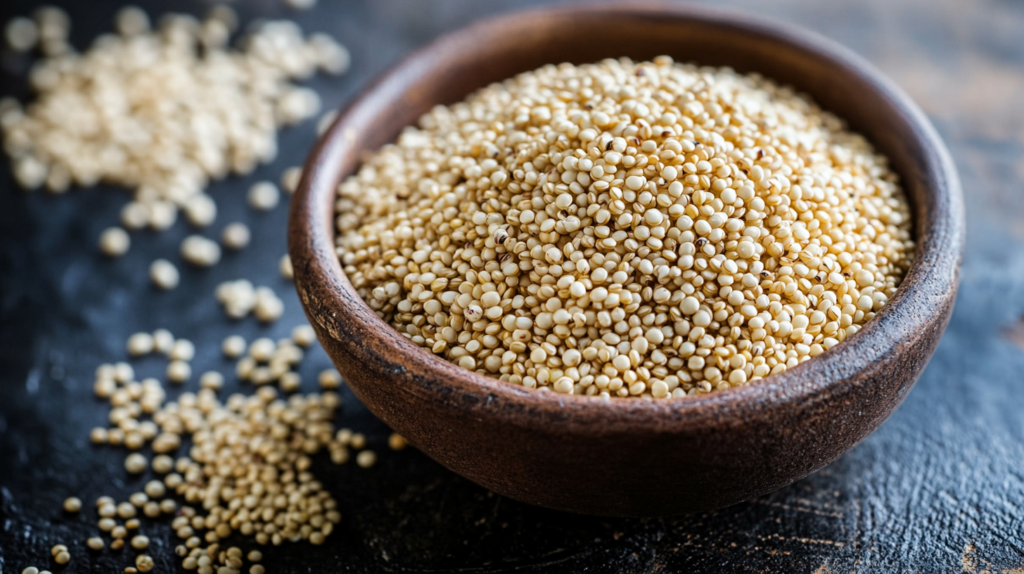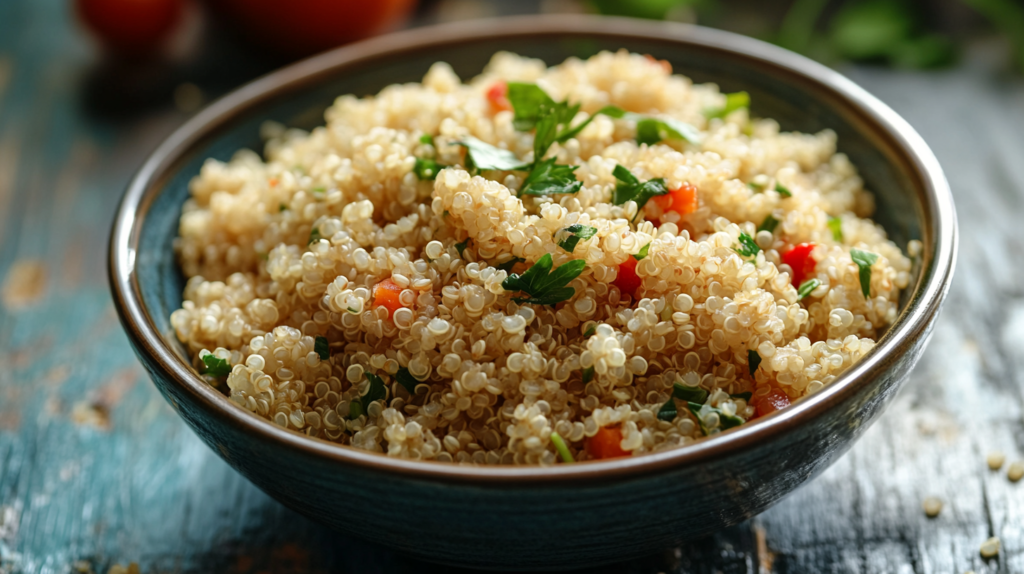Quinoa 101: A Beginner’s Guide to This Nutritious Superfood
In recent years, quinoa has taken the health food world by storm, and for good reason. This versatile, nutrient-packed grain has become a staple in many kitchens, beloved by health enthusiasts, busy parents, and food lovers alike. If you’re new to quinoa or looking to incorporate it more into your diet, you’ve come to the right place. In this comprehensive guide, we’ll explore what quinoa is, its impressive nutritional profile, and how to cook it to perfection. So, let’s dive in and discover why quinoa deserves a spot in your pantry!
This post may contain affiliate links. If you make a purchase through these links, I may earn a commission at no additional cost to you. Additionally, portions of this post may be generated using artificial intelligence (AI) technology. While we strive for accuracy, please be aware that AI-generated content may not always be perfect and should be fact-checked when necessary.
What is Quinoa?

Despite often being referred to as a grain, quinoa (pronounced KEEN-wah) is actually a seed. It comes from a plant called Chenopodium quinoa, which is related to spinach and beets. Originating in the Andean region of South America, quinoa has been cultivated for thousands of years and was considered sacred by the Incas, who called it the “mother of all grains.”
Quinoa comes in several varieties, with the most common being:
- White quinoa
- Red quinoa
- Black quinoa
- Tri-color quinoa (a mix of the above)
Each variety has a slightly different texture and flavor profile, but they can generally be used interchangeably in recipes.
Nutritional Benefits of Quinoa

Quinoa is often referred to as a “superfood,” and when you look at its nutritional profile, it’s easy to see why. Here’s a breakdown of the impressive health benefits quinoa offers:
- Complete Protein:
Quinoa is one of the few plant-based foods that contains all nine essential amino acids, making it a complete protein. This is particularly beneficial for vegetarians and vegans, as it provides a high-quality protein source without the need for animal products. For busy parents, this means you can serve quinoa as a protein-rich meal without having to worry about combining it with other protein sources. - High in Fiber:
With about 5.2 grams of fiber per cup of cooked quinoa, it’s an excellent source of dietary fiber. This can help promote digestive health, maintain steady blood sugar levels, and keep you feeling full longer – a bonus for those trying to manage their weight or feed hungry kids. - Rich in Minerals:
Quinoa is packed with essential minerals, including:
- Iron: Important for blood health and oxygen transport
- Magnesium: Crucial for muscle and nerve function, as well as bone health
- Zinc: Supports immune function and wound healing
- Potassium: Helps regulate blood pressure and supports heart health
- Phosphorus: Essential for bone health and cellular function
- Good Source of B Vitamins:
Quinoa contains several B vitamins, including folate, thiamin, and riboflavin. These vitamins play crucial roles in energy production, brain function, and cell metabolism. - Antioxidant Properties:
Quinoa contains various antioxidants, including quercetin and kaempferol. These compounds help protect your body against oxidative stress and may have anti-inflammatory effects. - Gluten-Free:
For those with celiac disease or gluten sensitivity, quinoa is a safe and nutritious alternative to wheat-based grains. - Low Glycemic Index:
Quinoa has a relatively low glycemic index, which means it doesn’t cause rapid spikes in blood sugar levels. This makes it a good choice for people managing diabetes or those looking to maintain stable energy levels throughout the day.
How to Cook Quinoa

Now that we’ve covered why quinoa is so good for you, let’s talk about how to prepare it. Cooking quinoa is simple, but there are a few key steps to ensure you get perfectly fluffy results every time.
Basic Quinoa Cooking Method:
Ingredients:
- 1 cup quinoa
- 2 cups water or broth
- 1/4 teaspoon salt (optional)
Instructions:
- Rinse the quinoa: Place the quinoa in a fine-mesh strainer and rinse under cold water for about 30 seconds. This removes the natural coating called saponin, which can make quinoa taste bitter.
- Combine quinoa and liquid: In a medium saucepan, combine the rinsed quinoa and water (or broth for more flavor). Add salt if desired.
- Bring to a boil: Place the pan over high heat and bring the mixture to a boil.
- Reduce heat and simmer: Once boiling, reduce the heat to low, cover the pan with a tight-fitting lid, and let it simmer for about 15 minutes.
- Let it rest: After 15 minutes, remove the pan from the heat but keep it covered. Let it sit for an additional 5 minutes.
- Fluff and serve: Remove the lid and fluff the quinoa with a fork. Your perfectly cooked quinoa is now ready to serve!
This basic method yields about 3 cups of cooked quinoa, which is enough for 4-6 servings as a side dish.
Tips for Cooking Perfect Quinoa
- Toast for extra flavor: Before adding liquid, you can toast the rinsed quinoa in a dry pan for a few minutes until it smells nutty. This adds depth to the flavor.
- Use broth instead of water: For more flavorful quinoa, cook it in vegetable or chicken broth instead of water.
- Add aromatics: Toss in a clove of crushed garlic, a sprig of fresh herbs, or a small piece of lemon zest while cooking for infused flavor.
- Don’t lift the lid: Resist the urge to peek while the quinoa is cooking. Keeping the lid on helps it cook evenly and absorb the liquid properly.
- Let it rest: The 5-minute rest after cooking is crucial for achieving fluffy quinoa. Don’t skip this step!
Troubleshooting Common Quinoa Issues
- Mushy quinoa: This usually means you’ve added too much liquid. Stick to the 1:2 ratio of quinoa to liquid for best results.
- Crunchy or undercooked quinoa: If your quinoa is still crunchy after cooking, it may need a few more minutes. Add a splash more liquid if the pan is dry, cover, and cook for an additional 5 minutes.
- Bitter taste: If your quinoa tastes bitter, you may not have rinsed it well enough. Make sure to rinse thoroughly before cooking.
Incorporating Quinoa into Your Diet
Now that you know how to cook quinoa, here are some easy ways to incorporate it into your meals:
- As a rice substitute: Use quinoa instead of rice in stir-fries, burritos, or as a side dish.
- In salads: Add cooked, cooled quinoa to your favorite salads for extra protein and texture.
- For breakfast: Use quinoa as a hot breakfast cereal, similar to oatmeal. Top with fruit, nuts, and a drizzle of honey.
- In soups and stews: Add cooked quinoa to soups and stews for extra heartiness.
- As a base for grain bowls: Create nutritious bowls with quinoa as the base, topped with vegetables, protein, and a flavorful dressing.
- In baking: Use quinoa flour in baking for a gluten-free alternative.
- As a stuffing: Use quinoa as a nutritious stuffing for vegetables like bell peppers or zucchini.
Frequently asked questions
Is quinoa gluten-free?
Yes, quinoa is naturally gluten-free, making it a great option for those with celiac disease or gluten sensitivity.
How long does cooked quinoa last in the refrigerator?
Properly stored in an airtight container, cooked quinoa can last 5-7 days in the refrigerator.
Can i freeze cooked quinoa?
Yes, cooked quinoa freezes well. store it in airtight containers or freezer bags for up to 3 months.
Do i need to rinse quinoa before cooking?
Yes, it’s recommended to rinse quinoa before cooking to remove its natural coating, saponin, which can make it taste bitter.
how much cooked quinoa does 1 cup of dry quinoa yield?
1 cup of dry quinoa typically yields about 3 cups of cooked quinoa.
Is quinoa healthier than rice?
Quinoa is generally considered more nutritious than rice due to its higher protein content and broader range of vitamins and minerals.
can i cook quinoa in a rice cooker?
Yes, you can cook quinoa in a rice cooker using the same water-to-quinoa ratio as you would on the stovetop.
Is quinoa keto-friendly?
Quinoa is relatively high in carbs, so it’s not typically recommended for strict ketogenic diets.
Can babies eat quinoa?
Yes, quinoa can be a nutritious addition to a baby’s diet, typically introduced around 8-10 months of age. always consult with your pediatrician first.
Does quinoa need to be soaked before cooking?
Unlike some other grains, quinoa doesn’t require soaking before cooking. rinsing is sufficient.
can i eat quinoa raw?
While quinoa can be sprouted and eaten raw, it’s generally recommended to cook it for better digestion and to eliminate any potential bacteria.
Is quinoa a complete protein?
Yes, quinoa is one of the few plant-based complete proteins, containing all nine essential amino acids.
Conclusion
Quinoa is truly a nutritional powerhouse that deserves a place in every kitchen. Its versatility, quick cooking time, and impressive health benefits make it an excellent choice for busy parents and health-conscious individuals alike. By understanding how to cook quinoa properly and incorporating it into a variety of dishes, you can boost the nutritional value of your meals while enjoying its delicious, nutty flavor.
Remember, the key to making quinoa a regular part of your diet is experimentation. Don’t be afraid to try it in different recipes or as a substitute for other grains. With its adaptable nature and numerous health benefits, quinoa is sure to become a favorite in your household. Happy cooking!







